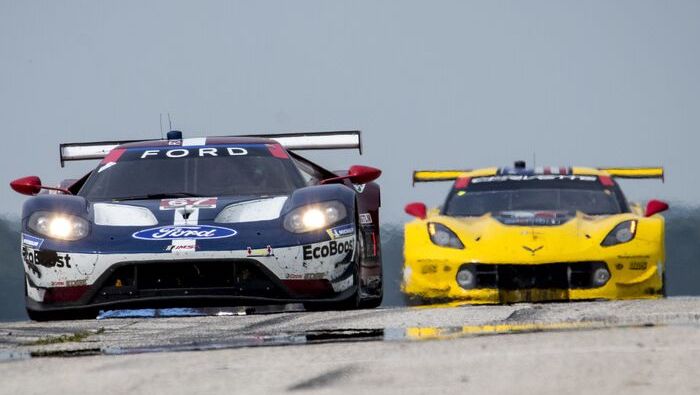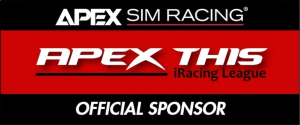Passing Guidelines
These passing guidelines are primarily for solo cars, not those in a close battle for a position (ie. within 1 second). Obviously, your battle is important but you still should let the faster cars by as early as possible using the methods below.
APEX THIS doesn’t have a blue flag rule where the slower car HAS to let the faster car by. However, good racing etiquette is not to slow the leaders if they are passing you. When executed properly, a pass will cost the slower car very little, or even no time. Not working together can easily cost both cars 1-2 seconds in a single corner.
This video provides a good example of both the good and the bad.
Awareness
Drivers should be aware of their surroundings at all times. Between corners, when you can straighten your wheel for a moment, check your mirrors and relative box. If it’s a long straight, do it several times. These glances only take a moment. “But”, you might say, “if I look at those things, I might weave or mess up my next corner. I’m doing everything I can just to go fast.”
Racing involves a lot of things. We want to drive fast but we have to look in the mirrors, at gauges, the relative box, and communicate to other drivers — all without having an incident. If you’re using 100% of your mental capacity to drive at the limit, how will you do the other things necessary during a race? You can’t. You’re leaving no margin to deal with the tasks that have to be done plus racecraft, surprises, and the many random events that happen during a race.
To make passing safe, you also need to know the racing line. If you aren’t driving the proper racing line, you can’t be predictable. If the driver coming up behind you sees you entering a corner from the middle of the track instead of the racing line, the driver doesn’t know your intentions. Are you giving them the pass? Is your car damaged? Are you confused? That driver will have to completely give up the corner or risk getting through the corner not knowing for sure the slower car’s intentions. This leads to accidents. Know the racing line.
Planning
When a car comes up behind you, you need to determine if it is someone in your own class you are racing for position, a car in your class in a higher position, or a faster class car. You need to be mindful of how fast they are closing. Start to work out where they will catch you and begin planning how to let them by.
To facilitate a safe pass:
- Be Predictable
- Make your intentions known early and obvious
- Communicate
Remember, as you are gauging how fast they are coming up behind you, they are doing the same. And they’re beginning to plan how they’ll pass you. If you make your intentions known early and obvious, they can readjust their plans earlier which then makes the actual pass safer, and faster, for everybody.
Now let’s talk about some specific racing scenarios.
Straights
This is the best place to let by a faster car. If done properly, it will cost both cars zero time. The slower car, with enough safe distance from the faster car (3-5+ car lengths), should make an obvious and aggressive move to the offline side of the race track. This makes your intention very clear to the faster car. “I’m letting you by.” A gentle drift to center track isn’t clear, the faster driver may not know what your plans are. Make your move early and obvious. This can often be done with no lift but one might be necessary if the straight is short or the speed difference isn’t that great. If you communicate your intentions to the faster driver, you can often tuck in behind the faster car at the next corner/apex which is much faster than going side by side through the corner.
Single Corner
If possible, the fastest way for the slower car will be to use what straight there is to let the faster car take the apex, and the slower car falls in line behind it, also able to take the apex. Sometimes this just isn’t possible. Often the pass will need to be done in a corner as this is where most faster cars, or faster drivers, make their speed. The safest and fastest way for both cars through the corner is for the slower car to make an early and obvious (1-2+ car lengths) move to the outside of the line entering the corner. Letting the faster car take the apex. Do this early enough so everyone knows the plan. If you wait too late, the faster car may plan to pass you on the outside. Then you move to the outside too and, well, bad things happen. Again, the key is early and obvious (and communicate if possible). Generally, a lift will be required by the slower car.
This is faster than not working together, not knowing the other’s intentions and both cars lifting through the corner side by side and now, off pace. Or worse, causing a collision.
Linked Opposite Direction Corners (S-Corner)
Assuming the faster car hasn’t caught you before the first apex (see single corner), the best course of action is for the slower car to take the first corner in the S, corner A, normally and at full speed. Then between corners A and B, the slower car should stay straight, allowing the faster car to take the normal racing line (middle of the “S”). Again make this early and obvious. Don’t mildly drift offline or go center track. That isn’t clear enough.
Once the faster car is clear of the slower car’s backside, the slower car can do a mild lift. Don’t do the mild lift too early, while the faster car is still directly behind you. This could cause a rear-end collision, or cause the faster car to make an evasive maneuver which results in a loss of control.
Linked Same Direction/Double Apex Corners
Typically a combination of the “Straight” or “Single Corner” ideas work well here. Often the faster car will have to wait until both are through the double apex corner.
Faster Car Makes The First Move
Sometimes the car coming up behind you will be the first to show its intentions. If you see them pop out of line behind you, they’re letting you know they plan to pass on the straight or at the next corner. The faster car again should make this early and obvious enough for the slower car to see, recognize, and make a plan.
Exceptions to the Rule
There are times none of the above is possible. Such as the Esses at COTA or when the slower car is in a heated battle with the car ahead (under 1 second). However, if everyone does their best to work together and facilitate a safe pass, all the races will be cleaner, we’ll have faster lap times and in the end, way more fun. Isn’t that what we all want?
Summary
In all these examples, the key is early, obvious, and predictable. If you wait a bit too long, the other car, faster or slower, will already be committed to their plan and they won’t be able to deviate without causing a wreck, that might involve you.
Watch your mirrors and relative box constantly. Be aware of your surroundings at all times. Know the closing rates of the cars behind you. If all this is too much to do at your current pace/skill level, then slow down or consider our MX5 races. The MX5 races are an excellent way to build these skills without the radical speed differences in class racing.

